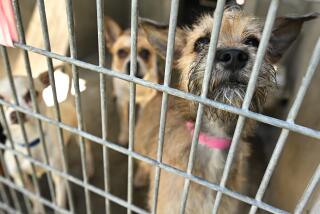Pet Peeves
- Share via
The brouhaha over how an Encino pug dog was skinned and left to die, whether by man or coyote, reflects the continuing controversy over coyote trapping, a fight that pits an obscure city agency against passionate, often vehement animal rights activists.
The animal lovers, backed by several independent veterinarians, insist that human hands removed the dog’s pelt--and to the untrained eye, graphic photos of the slain creature’s neatly sliced skin seem to support their claims.
But other experts say the clean cuts are typical of a carnivore attack, whether it be a coyote, another dog or a predatory bird, such as an owl or eagle.
“I’m surprised they’re not saying it was aliens from outer space,” said Dr. Charles Leathers, a leading research veterinarian. Indeed, one animal rights advocate claims with certainty that the killing was the work of a satanic cult.
The Society for the Prevention of Cruelty to Animals Los Angeles--which has enforcement powers under state law--is continuing its investigation to track down a human attacker.
Meanwhile, animal rights activists are accusing the city’s embattled Animal Services Department of inventing coyote attacks to justify a renewal of coyote trapping, abandoned four years ago to mollify the activists. Department officials vehemently deny the charge.
The case of the unfortunate pug, left to fend for itself overnight in the suburban jungle, has taken on a whole array of meanings in the minds of all who hear about it and is unlikely to be resolved to anyone’s satisfaction.
What the case has revealed are the contentious battles among the varied schools of animal advocates.
“There is more bickering and infighting in the humane community than in any group of people I have seen in my entire life,” said Gini Barrett, a city animal regulation commissioner and western regional director of the American Humane Assn. “If we would all spend as much time [working for animal welfare] as some of us do bickering, a lot more animals would be better off and more people would join us in our work.”
But the controversy over Pal the pug has triggered a new barrage of name-calling and accusations. City Council members are pointing fingers at one another and at Animal Services officials. Animal Services alleged “obstruction of justice” in its investigation and obtained a warrant to search the office of the private veterinarian who first treated the dog. Department officials proposed unsuccessfully to the city attorney’s office that the perished pug’s elderly owner, who is deaf and nearly blind, be charged with negligence for failing to get her pet’s wounds treated immediately.
The SPCA lashed out at Animal Services, accusing General Manager Gary Olsen of “political bickering” and “public whining.” The Southern California Veterinary Medical Assn. stepped in to quiet the fighting among its members.
And in the end, wildlife supporters were once again accusing the city of a subterfuge to overturn the Animal Services commission’s ban on coyote trapping while those on the other side of the fence say the real danger is to ignore the presence of coyotes in the city--and the need to protect pets from them.
*
Following dozens of cities and counties throughout the state, the Los Angeles City Council in 1993 banned trapping coyotes and other wild animals, except in extraordinary cases requiring a special permit.
The ban brought complaints from many residents, particularly those in the west San Fernando Valley who complained of attacks on pets and other small animals and threats to small children. But animal rights advocates fought back even harder.
Initially, the Animal Services Department supplied traps to homeowners in special circumstances, but halted even that practice in May 1995, said Peter Persic, the department’s spokesman.
No permits have been sought to trap coyotes in the last two years, he said.
But “this case has absolutely nothing to do with coyotes and coyote trapping,” he emphasized.
“With this dog attack, we investigated the case, we reached a conclusion and that is the only issue that should be involved in this.”
He added, however, that he is not surprised by the outbreak of new accusations. Whether or not coyotes should be trapped “is a perennial issue and there is absolutely no way that everyone is going to be satisfied with any policy,” he said.
The fear that the department is moving to renew trapping “is absolutely not true,” he said. “Trapping is simply not an effective way of coexisting with wildlife.”
Barrett said the arguments repeatedly put animal control officials “between the devil and the deep blue sea. The way you know you have picked the right option is when everybody is mad at you.”
Despite the infighting, all the animal advocates agree on one point: The best way to reduce the number of mutilated and missing pets is to keep them inside at night, remove pet food from outside and cover garbage cans--all steps to avoid attracting coyotes.
“If Pal’s death is to go to good, what needs to happen is not for all of us to scream and holler at each other about right and wrong, but to use this as an opportunity to learn how to protect our pets,” Barrett said. “If we know how to protect our pets from coyotes, then they will also be protected from people.”
More to Read
Sign up for Essential California
The most important California stories and recommendations in your inbox every morning.
You may occasionally receive promotional content from the Los Angeles Times.










